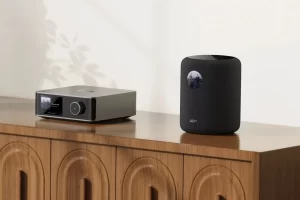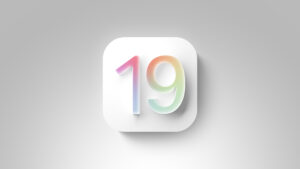Technics Ottava review: The SC-C70MK2 is an all-in-one entertainer
[ad_1]
Compact in dimensions but not in features and performance, the Technics Ottava f SC-C70MK2 is a next-generation all-in-one sound system infused with a most congenial and accommodating spirit. A personality kid with lots of pizazz, almost juke-boxish in its bubbly effervescence, the Ottava f is tuned to bring out the entertaining best in almost anything you throw at it via hard goods (CDs), streaming services, broadcast radio, and outboard devices, too.
A musical term, the Italian “ottava” means “at an octave higher or lower than written,” and the f is for “forté,” fitting descriptions for this overachieving music system that likewise scribbles outside the lines, confounding expectations for what an all-in-one music box can deliver.
The top-mounted CD player has an interesting roll-away cover that requires a tad of rear clearance. It closes with the assistance of a magnet, and the player won’t spin until it’s secured.
Even before you turn it on, the stylish looks and solid build make a strong first and lasting impression in this thousand-dollar bundle of goodness. There’s so much to like here: the premium-grade brushed-aluminum top and gray-finned front; the tactile hands-on operation, with top-mounted physical buttons for power and volume; and the flush, touch-sensitive transport and mode buttons. Adjacent is an innovative swing-around cover exposing the CD player. Made of thick, smokey plexiglass, the lid looks durable, but keep it out of tykes’ reach.
Operation also is possible from a generously sized IR remote control (with nine dedicated programmable Favorites buttons) and—best of all—from the easily mastered, mostly cooperative Technics Audio Center (TAC) app for your smartphone or tablet. TAC communicates to the music box via the same dual-band Wi-Fi 5 connection the Ottava uses to play music from streaming services.
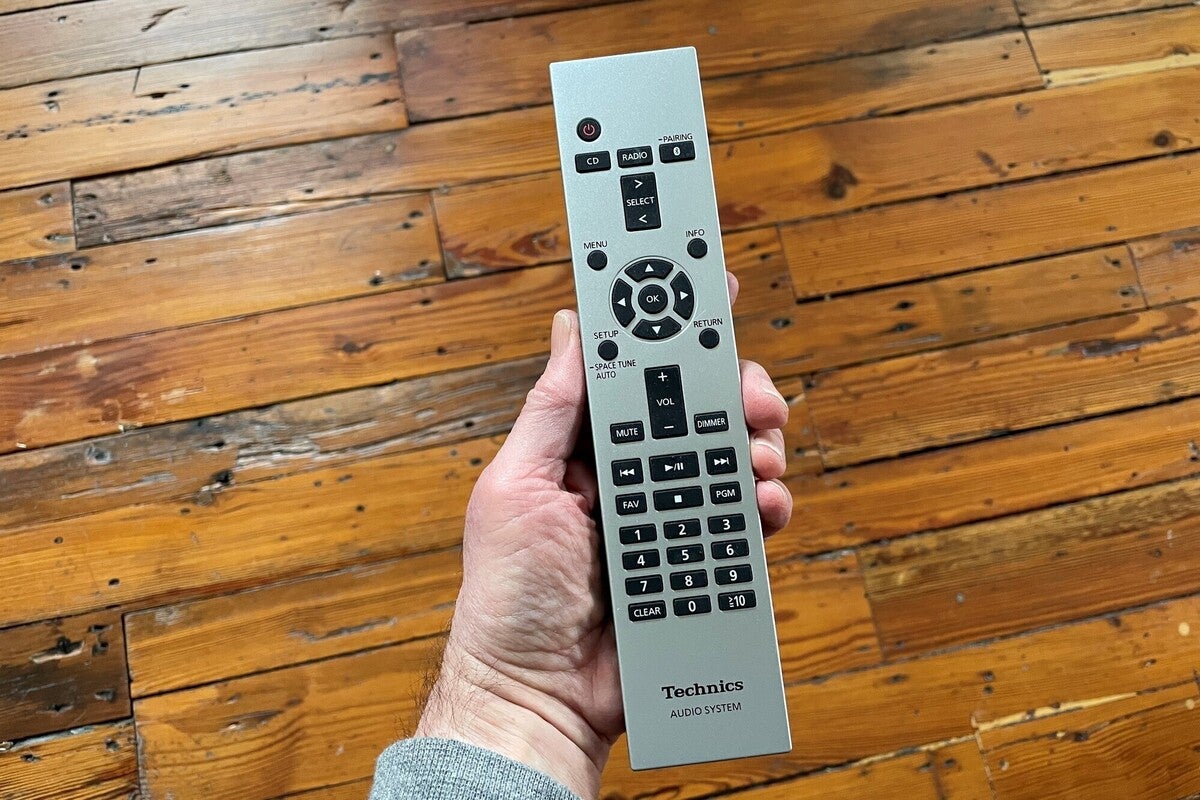 Jonathan Takiff / IDG
Jonathan Takiff / IDGThe full sized remote control is a helpful show starter, although the reception range of the Ottava’s infrared receiver’s is narrow.
If your home suffers wireless signal congestion, there’s a 10/100 ethernet port for hardwired network connectivity in back, along with inputs for optical digital audio (Toslink), 3.5mm analog audio, and a USB-A port for hosting stored media. A 3.5mm headphone jack is hiding in the front display zone, but this system sounds so pleasing on its own that I felt compelled to plug in my Andover PM-50 planar headphones only to prove the circuitry was satisfactory. And it is.
To a degree, the Ottava’s relatively small footprint and integrated nature trades on the ultra-compact “executive stereos” that first came on strong in the 1980s. Those mini and micro kits were likewise fitted with an integrated amp, speakers, CD player and FM/AM tuner section, and were often found humming in private offices.
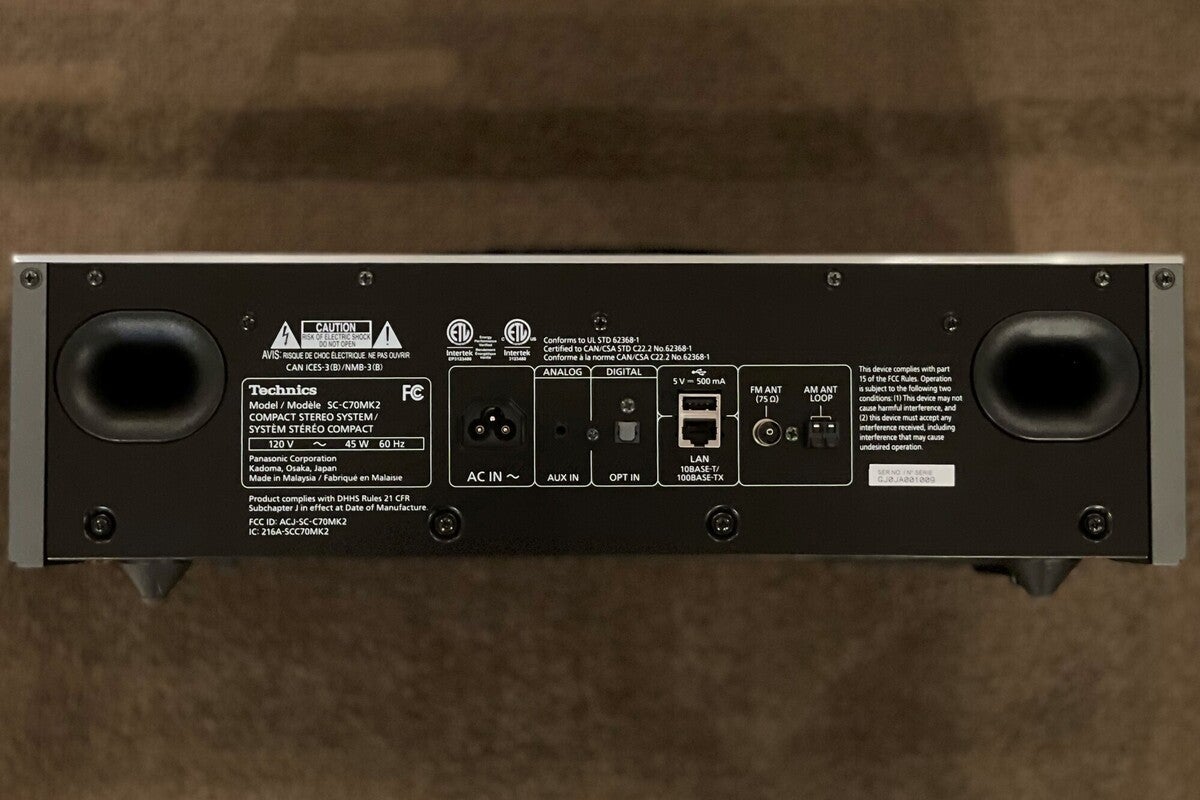 Jonathan Takiff / IDG
Jonathan Takiff / IDGThe rear jack pack covers the bases, with analog and optical digital (Toslink) inputs, a USB-A port, and 10/100 ethernet.
But with its additional streaming aspects and one-piece nature, Ottava’s most obvious rivals today are the very compact Bose Wave Soundtouch Music System IV and the mid-sized, wood-encased Como Audio Musica I reviewed a couple years back. Both are priced around the $600 mark—40-percent less pricey than Ottava—and both are appealing in their chosen domain. But neither has quite the sonic sizzle or versatility of this larger-footprint show-off.
If you’re willing to pay the extra freight and have the larger tabletop space demanded, you will be rewarded with a more aggressive, dynamic Hi-Fi experience here. Technics literature calls Ottava a system for “casual enjoyment of high-quality music;” meaning, I suppose, that content is easy to access on it. But that phrase “casual enjoyment” also sounds a bit defensive and dismissive, which isn’t necessary. An Ottava could more than suffice as a pinched-for-space music lover’s one-and-only rig. It could also upgrade said user’s TV sound given adequate space beneath a wall-mounted TV or one installed in an entertainment center (provided they’re willing to get by without an HDMI connection).
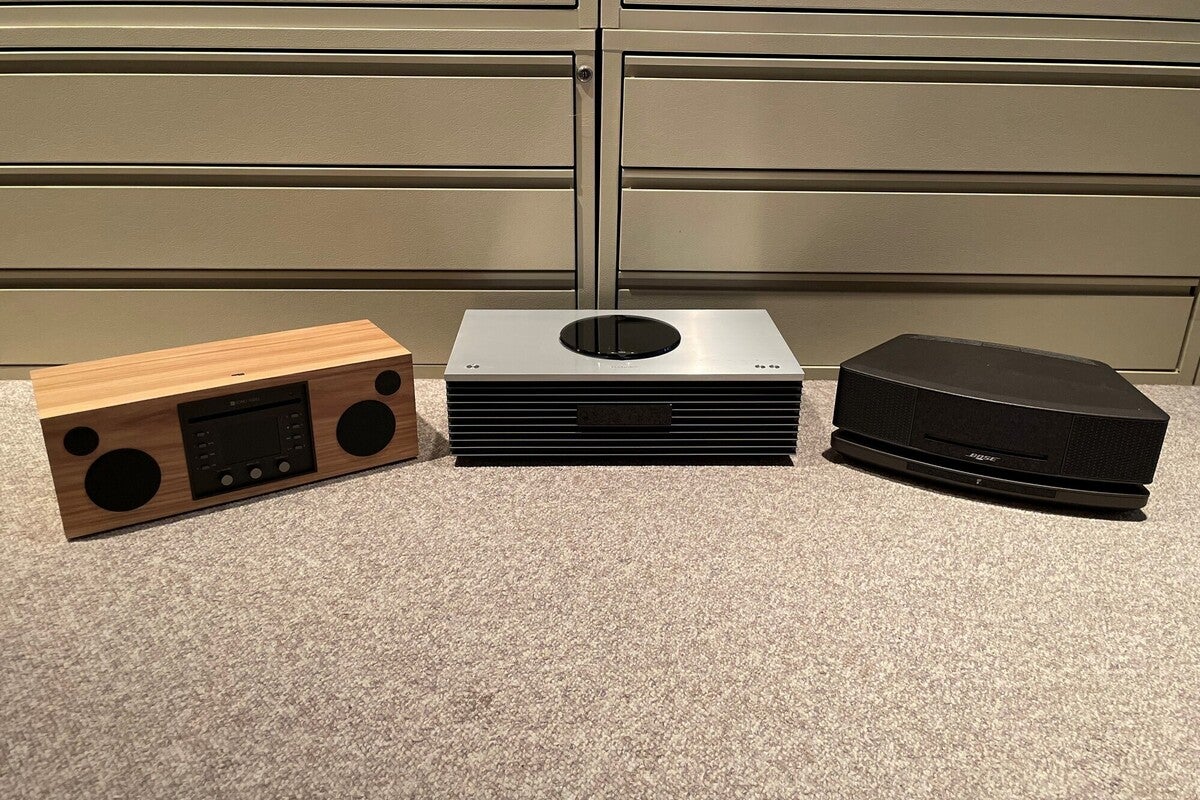 Jonathan Takiff / IDG
Jonathan Takiff / IDGThe Technics Ottava SC-C70MK2 (center) meets its competition: The Como Audio Musica (left) and the Bose Wave SoundTouch Music System IV.
With its high-end fit and finish, this 17.75 x 11 x 5.6-inch (WxDxH), 17.7-pound package also harkens to such premium-grade—but CD-snubbing—compact music centers as the cosmetically similar Naim Mu-so. Ottava costs about $700 less than Naim’s all-in-one, and the big black circle on its top does more than adjust the volume. The second-gen Mu-so, on the other hand, supports HDMI with ARC.
The Ottava makes whistle-clean and robust music with an interference-eliminating twin power supply circuit system and three JENO-engine (Jitter Elimination and Noise-shaping Optimization) digital amplifiers that deliver 30 watts per channel to twin pairs of 3.15-inch woofers and .79-inch silk dome tweeters, and 40 watts to a 4.72-inch down-firing subwoofer. That integrated sub is the secret weapon in the Ottava’s sonic arsenal.
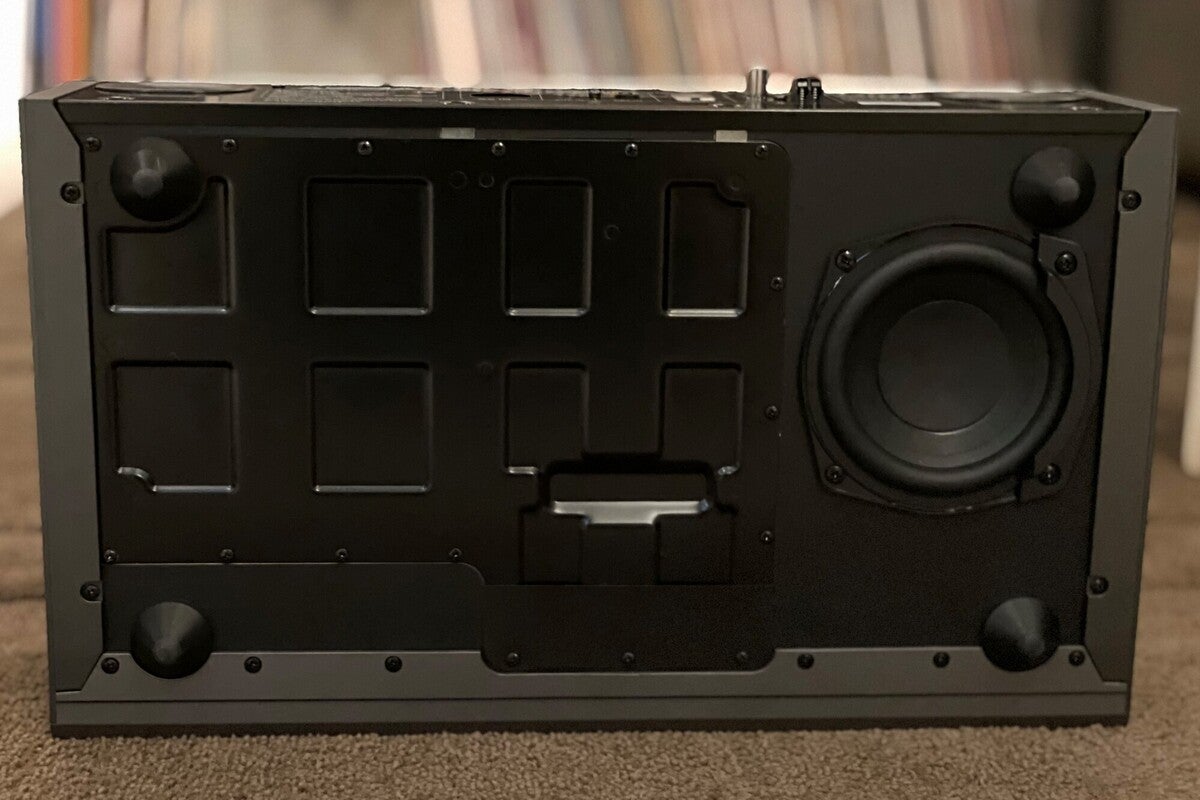 Jonathan Takiff / IDG
Jonathan Takiff / IDGUnencumbered by a speaker cover, the downfiring subwoofer kicks tight, full, extremely well-defined bass.
If you appreciate a tight, extremely well-articulated bottom end in your music, combined with a bright and forward mid/upper range (a Japanese sonic obsession,) you’ll delight in how the music comes together here. The sub is spec’d to extend down to 70Hz with THD of 1%, but my ears tell me you’ll hear zero fuzz at normal (25- to 60-percent) listening levels. I heard overt blurring only when I pushed the volume to the max output level—a don’t-try-this-at-home 110dB—or when I plopped this music maker on a rickety table where the resonating kickback from that down-firing woofer can really get out of hand.
Hearing is believing
Encouraged by Technics’ rally call in the owner’s manual to “rediscover music,” I first pulled out some of the classic swing-themed albums (on CD and streamed in high-res) that Frank Sinatra recorded for Capitol Records more than 60 years ago. I was staggered anew by how vital and fresh they still sound on this rig. (First opened in 1956, Capitol Studios in Hollywood remains an esteemed sonic environment—which is why folks such as Diana Krall, Bob Dylan, Green Day, Beck, Paul McCartney, and Imagine Dragons still flock to record there.)
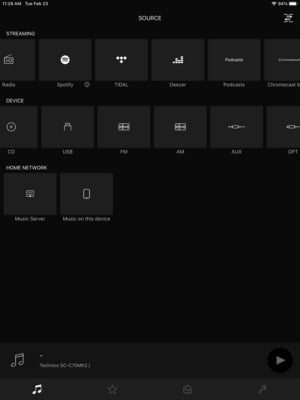 Jonathan Takiff / IDG
Jonathan Takiff / IDGTechnics’ Audio Center app (seen here in iPad version) isn’t flashy, but it gets the job done.
Most strikingly revealed (and celebrated) by the Ottava was the playful, ultra-inventive Nelson Riddle big-band arrangements, as horns wail, flute flutters, strings swell, and drums splatter; and the way stand-up bass player Joe Comfort inventively interfaces with Sinatra in what was arguably his prime. Check out such gems as “Night and Day,” “You Make Me Feel So Young,” and “I’ve Got You Under My Skin.” What a blast!
Listening to Norah Jones’ beautifully engineered debut Come Away With Me on the Ottava, I felt as though I was hearing the album for the first time. Likewise for Richard Thompson’s electro-folk collaboration with master producer Mitchell Froom, on Mirror Blue. And the Ottava infused Queen’s sonic showcase Night at the Opera with bombastic grandeur. I can’t say this system makes everything sound spectacular. I was hoping to gain new insights from my all-time fave classical/rock-fusing group Procol Harum, but their London-fogged/Westminster Abbey-heavy organ aura hasn’t aged that well. And if it ain’t in the grooves, Ottava can’t make its moves.
What’s the secret sauce?
Updates to the new model include redesigned acoustic lenses placed in front of the tweeters that help throw sound far to the left and right of the box as well as forward. But given the close proximity of the left and right drivers—spaced less than a foot apart—you’re not going to get any sense of stereo separation unless you’re seated directly in front of the unit at eye and ear level. That’s how I listened to it in my home office, with the box plopped atop a low Ikea bookshelf. This straight-on spot also proved to be the best way to read the challengingly small (1/8-inch-high max) front display text that spells out the source, track, and music title. Larger fonts on the Bose Wave and the color screen on the Como Musica make their displays easier to scope.
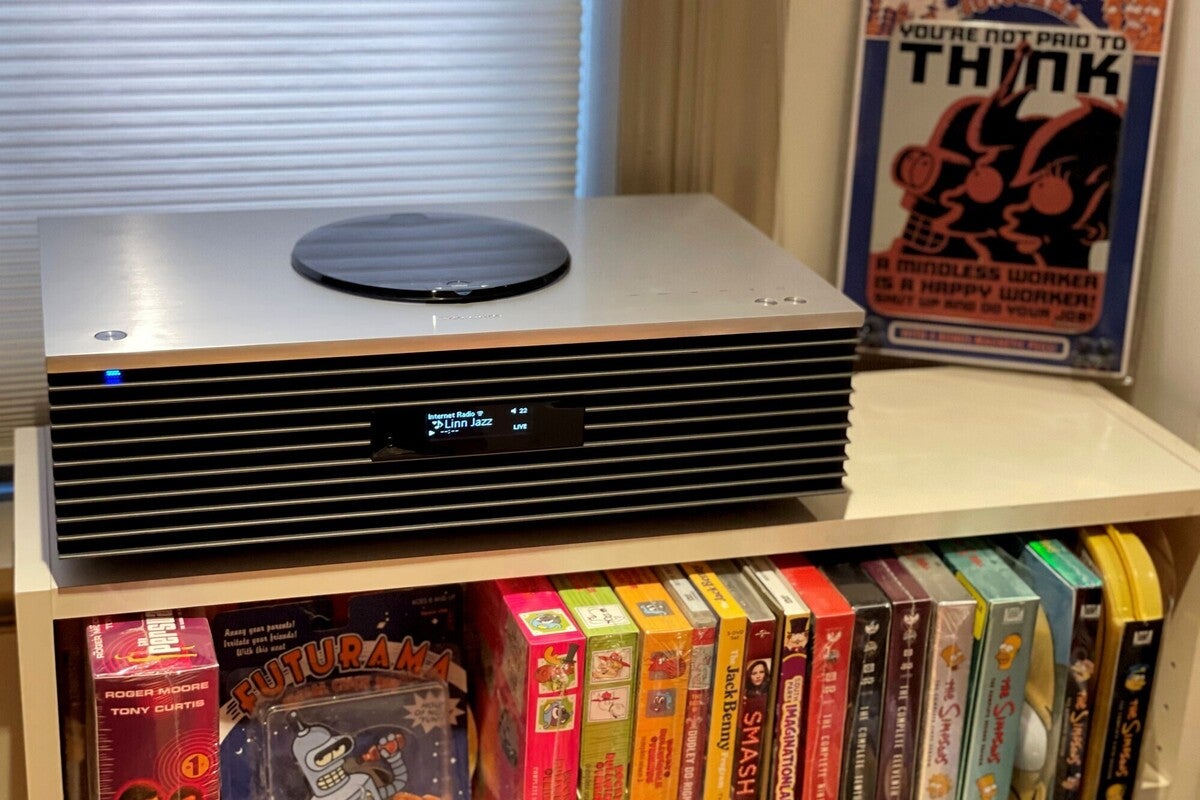 Jonathan Takiff / IDG
Jonathan Takiff / IDGThe best way to read the Ottava’s display—and discern its stereo separation—is to place it on a bookcase at eye level.
The full and balanced sound coming out of this foxy box also can be attributed to the newly refined automatic signal calibration system, dubbed Space Tune. EQ presets are available for three locations: free/open, near the wall, or near the corner. For best results, Technics requests you recalibrate with a one-touch tap whenever moving the Ottava to a new spot. Squonky, spacey noises are output and reflected back from surfaces to a built-in microphone, causing the system to modify its frequency amplitude and phase timing—a DSP process Technics calls Load Adaptive Phase Calibration. I could literally feel it working by putting my hands up against the rear-firing ports.
When the Ottava was plopped in the middle of a granite-top kitchen island, the system didn’t bother firing any energy out the back ports. But after I repositioned and retuned it atop a sturdy dining room sideboard, just a foot forward of a back wall, the player really kicked up its heels. This became my favorite listening spot. Space Tune suddenly decided to push lots of bass-extending wind out the back ports and maybe upped output from the down-firing woofer as well—so much so that when I placed an Audio Technica AT-LP60X turntable, which has a built-in phono pre-amp, alongside Ottava, the phonograph needle kept jumping out of the groove. Later, duly separated and isolated, the bargain turntable got along famously with the Ottava, co-producing a warm, rounded sound that vinyl-fans will treasure.
 Jonathan Takiff / IDG
Jonathan Takiff / IDGThe Ottava sounded its room-filling best on the dining room sideboard, seated on a solid wood tabletop with its rear ports firing into well-damped (insulated) drywall.
I encountered no such tracking problems with the onboard, top-mounted CD transport, as Technics has much expertise in disc players. But it surprised and slightly annoyed me that the transport doesn’t play high-res SACD discs. It’s a feature found in the Ottava’s first cousin, the Technics SL-G700—a high-end combo network/disc player that goes for about three grand. Another feature you won’t get with the Ottava is MQA support, meaning you won’t be able to unfold the final ultra-high-res layer of Tidal’s Master recordings. That’s another skill you’ll find on the SL-G700. I’m guessing Technics passed on licensing MQA to hit its $1,000 price point.
The Ottava can decode DSD files—2.82MHz (SACD grade), 5.6MHz, and 11.2MHz—stored on a server or a drive plugged into its USB-A port. It will also decode WAV and AIFF files with up to 32-bit resolution and sampling rates as high as 384kHz, as well as up to 24-bit/384kHz ALAC and FLAC files. AAC and MP3 files are supported at bit rates up to 320Kbps at sampling rates up to 48- and 96kHz respectively, which is certainly good enough for internet radio. And if you enjoy listening to poor-relation global stations, you can try buffing that low bit-rate content with Technics’ “Re-Master” processing, though the sweetening is subtle.
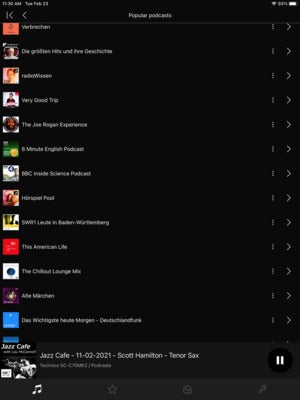 Jonathan Takiff / IDG
Jonathan Takiff / IDGThe app’s Popular Podcasts list underscores the Ottava’s international audience, with content from Germany, Britain and the now-playing Jazz Café from New Zealand.
You’ll also find native support for most of the popular music-streaming services, including Deezer, Spotify Connect, Airable internet radio and podcasts, and the aforementioned Tidal. You can stream music from mobile devices using Bluetooth 4.2 (5.2 was introduced at CES—in 2020), but there is no support for higher-resolution codecs such as aptX or LDAP. Not surprisingly, music streamed over Blutooth sounded mid-fi at best, but it traveled far—more than 40 feet. Chromecast support delivers higher resolution, and multi-room audio can also be accomplished with that or with Apple’s Airplay 2.
There are two powered speakers in the Ottava family that support both of those multi-room audio technologies, the SC-C30 ($650) and the SC-C50 ($800), but there are plenty of less-expensive alternatives. Once I’d created a group in the Google Home app, I used my smartphone to stream content from the Qobuz and Napster music-streaming services to the Ottava in one room, an $80 JBL Link Music Smart Speaker in another room, and a $399 Russound MBX-PRE in a third. And while the Ottava’s onboard mic doesn’t respond to commands spoken to Google Assistant, the group had no problem responding to requests barked to the JBL smart speaker.
So, yeah, the engineers at Technics have a few things they can work on when designing the third-generation Ottava, but nothing that should make you say “I’ll wait for the 2024 version.” Life’s short and this sweetie is ready to rock your socks off right now.
[ad_2]
Source link






